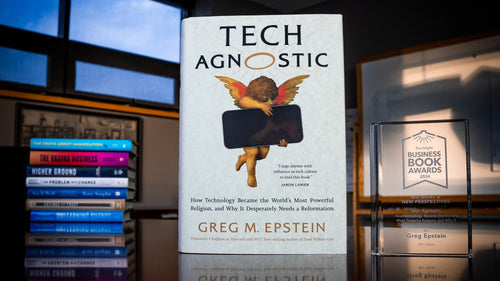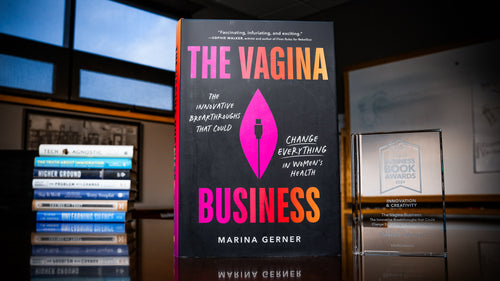Make Some Noise: The Unconventional Road to Dominance

The former director of communications at Harley-Davidson and one of the most sought-after speakers in the world reveals his exhilarating, innovative approach to creating customer loyalty and marketplace dominance.
Ken Schmidt is a wanted man. His role in transforming Harley-Davidson Motor Company—one of the most celebrated corporate success stories in history—led business leaders all over the world to seek his guidance. After all, how many companies can get their customers to tattoo their logo on their arms?
After having worked with more than one thousand companies worldwide, Schmidt is ready to share the secrets that spurred Harley-Davidson’s remarkable turnaround. An avid motorcycle enthusiast, Schmidt harnessed his passion for riding to create his famed Noise Cubed Trilogy—the three questions he asks every one of his clients. They assess a company’s positioning, competitiveness, and reputation, and are the key ingredients for any successful corporation: What do the customers your business served yesterday say about your business when they’re talking about you to prospective customers? What do you want them to say? What are you doing to get them to say it?
In Make Some Noise, Schmidt shares his full-throttle approach for businesses and individuals alike. Anyone looking to become more competitive and grow customer loyalty can learn from the case studies and experiences he shares. From a nondescript heavy construction company, to the most high-end “luxury” gas station in America, to Apple, and to his own personal landscaper, Schmidt illustrates how the answers to his trio of questions will yield a course of action to stand out in today’s marketplace.
In the excerpt below, Schmidt shares the concept of Noise Cubed.
NOISE CUBED
You’ve got work to do—your first official assignment—but it’s only going to take you a minute. I want you to type out, word for word, what you see in the box below. Then print it out and display it in the most visible area of your workspace so you and people working with you can see it.
Noise Cubed
- What are people saying?
- What do we want them to say?
- What are we doing to make them say it?
(Personalize this by replacing the “we” with “I” if you want.)
I promise you that this little crib sheet I invented in my first job out of college is going to be as helpful to you and the others you share it with as it’s always been for me. It’s going to sit at the top of your business processes as the driving force of your competitive strategy and constantly remind you and everyone working with you what you’re working toward.
It’s also going to make you a smarter, sharper communicator because, by the time our journey together winds down, you’ll be much more thoughtful and consistent with the words and messages you share with your important publics. Equally important, you’ll find it to be a bulletproof touchstone for decision making, as in “Will this action, new product, or statement we’re considering make people say about us what we want said?”
I still have the faded and tattered 8 1/2" x 2" sheet I first taped to the top of my typewriter(!) at Harley-Davidson (only it didn’t have the “Noise Cubed” title on it because I didn’t have a name for it then). It served me and the company very well, as it will you.
You see, back then I was tasked, broadly speaking, with improving the company’s reputation and making it more attractive to prospective motorcycle owners and investors at a very low point in its then-eight-decade history. At that time, Harley’s noise—and corresponding bank balance—were deep in the danger zone, the results of a particularly nasty (and, in retrospect, totally preventable) one-two punch: Preposterous “outlaw biker gang” stereotypes hovered over the company’s customer base and everyone associated with it (bike dealers and, of course, the company as a whole), while grossly exaggerated product reliability issues were taken as gospel in the marketplace.
Naturally, Harley’s competitors weren’t dumb, so they took full advantage of this. Honda, in particular, launched a brilliant offensive to take advantage of those negative stereotypes and gained worldwide acclaim for one of the most successful marketing campaigns of all time, “You Meet the Nicest People on a Honda.” They implied directly and successfully that the folks riding Harleys weren’t so nice while Hondas were for everybody and in very little time took claim to the top of the worldwide bike market. Meanwhile media outlets seemed to relish saying that the Harley-Davidson—the sole remaining U.S.-based motorcycle manufacturer—had outlived its usefulness and was writing its own obituary. Probably because it was.
What would you have been thinking about, if you were me?
There were lots of very well-intentioned voices and ideas from various areas of the company offering suggestions on how to approach this. Which is precisely why Noise Cubed is so valuable. There’d be few if any second chances, so I needed to get focused immediately on what was most important and get strategic on the double. If we couldn’t figure out a way to get the people most important to Harley-Davidson to talk about us the way we wanted to be talked about, we were screwed. Period. It’s well worth saying, too, that being essentially broke meant there was very little money to play with, so there was no way Harley was going to promote or buy its way out of this mess.
Those gang stereotypes I just mentioned were spawned and perpetuated by Hollywood and the media world, highly influential voices who found in riders of large, loud, attention-grabbing motorcycles (spelled Harleys) something they could use to instill fear into the hearts of non-Harley riders (spelled the majority of the human race) everywhere. The huge, often ridiculous falsehoods used to “substantiate” these stereotypes (chain-swinging violence, murder, drugs, kidnapped teenaged girls, etc.) spread like wildfire and were, to say the least, a very strong purchase deterrent.
At least two full generations of children were raised in a world where they were told that guys who rode and sold Harleys were thugs. I grew up liking every bike manufacturer except Harley. I nearly passed out once as a teenager when my Honda broke down and I pulled to the side of the road just in time for a group of Harley riders to pull up. I was scared to death that they were going to light me on fire, something I’d heard they regularly did to riders of Japanese motorcycles in those days (I’ll not say here how they reputedly “extinguished” those burning riders). Forty-some years later I’m still embarrassed to say they actually helped get me on my way.
You can find on my website stories about how and why this “outlaw biker” phenomenon came to be. It’s great campfire storytelling (if I say so myself).
You don’t need me to tell you that misinformation creates all sorts of obvious problems and that it’s just plain wrong to stereotype and judge people by their appearance (and that the world would be an infinitely better place if we’d all just stop doing that). But here’s something important we can learn from these negatives that most people don’t think about and that’s relevant to all businesses: When what we see and experience in real life doesn’t match what we’ve been led to believe, there’s an instant disconnect. So the legions of Harley riders who didn’t look like “outlaw bikers”—picture your mailman or everyone’s grandpa riding past your house on his bike—didn’t blip on anyone’s radar because they didn’t look the way everyone expected Harley riders to look. Meaning they were invisible and, thus didn’t exist and certainly weren’t talked about.
The opposite of that equation is equally problematic: When what we see and experience in real life matches what we’ve been lead to believe, we then believe even stronger. Which explains why I freaked when those Harley riders approached my broken-down Honda or why, when you saw some biker-looking dudes rolling through town, you assumed—because they looked just like the guys in the B-movies and that Mom warned you about—they were Hell’s Angels–types on a drunken killing spree. Oh, the humanity. (They were probably heading to a picnic. With badminton.)
A reporter at the New York Times inadvertently set me straight on this and gave me one of those radical perspective changes I mentioned earlier. Very early in my reputation repair work, when I was telling her about the “real” riders who made up the vast majority of the Harley-riding family, she cut me off and told me she was having none of it. “All I know is what I see,” she complained. “And what I see are rough-looking bikers. Case closed.” (Me: “But . . . but . . . but . . .”) Little wonder, then, that Harley’s defensive, “Look at us for who we really are,” messages hadn’t yet resonated with the masses. (That reporter has no idea how many times I’ve invoked her in discussions with business leaders over the years, especially those running businesses that make promises and claims they don’t deliver on. And I’d bet you can name a lot of those. All we know is what we see.)
So suffice to say that pretty much everyone in the non-bike-riding world harbored very negative perceptions about Harley-Davidson. That’d make it a little tough to attract new customers, wouldn’t you say? Would you have bet your retirement funds on a company with such a black cloud over its head? (By the way, I was kidding about the badminton a minute ago.)
As destructive as Harley’s “outlaw biker” image was, though, it wasn’t the company’s biggest problem. The second blow of that nasty one-two punch was much more destructive and is certainly one that any business owner can sympathize with: The most important people in the company’s selling dynamic—millions of motorcycle owners riding competing brands (aka “the bike market”)—would tell anyone who’d listen that Harley’s products were hugely unreliable (I’m being polite here; their language was much more colorful).
Like a lot of old-line manufacturing companies, Harley was guilty of producing some less-than-great products in the 1970s and early 1980s. The company’s quality had indeed declined and in many ways paled when compared to the stuff rolling off assembly lines in Japan and Germany, the then-perceived world heavyweight champions of quality. But Harley’s quality wasn’t anywhere near as bad as these folks, most of whom had exactly zero experience with Harleys, were saying. Nobody’s could be! But who cares? Paraphrasing the late, masterful comic Rodney Dangerfield, who once argued, “When a kid says you’re fat, you’re fat.” When the most important people in your market say you stink, you stink.
Harley stunk.
Who were riders telling their “Harleys stink” stories to? Anyone shopping for a bike or even considering it. Harley’s protests to the contrary, naturally and tellingly, fell on deaf ears. Who’d be crazy enough to buy a Harley against this backdrop?
Two platinum-clad lessons can be taken from this:
First, if the market (or any people important to you) owns your narrative, you’re totally out of control and in big trouble.
Second, everybody turns a skeptical ear to what businesses and people say about themselves, but we attach a ton of belief to, act on, and repeat what we hear from others. Negative voices and inaccurate stories can create a lot of damage quickly, right? (See: 2016 U.S. presidential election.) It’s sad and telling that businesses spend and spend and spend hoping to reverse this and make you believe what they say about themselves. God, what a waste.
Both of these lessons validate Noise Cubed and the need to make vocal advocates—saying what we want said and how we want it said—out of those we depend on.
Lots of times when I’m telling stories like this about Harley’s struggles, people ask, “Is that when Harley rebranded?” and it always makes me cringe. Uh. No. That term hadn’t even entered business vernacular yet and, to put it bluntly, I often wish it never had. I’ve seen way too many businesses—especially small ones—waste way too much time, effort, and money chasing something—“branding” or “rebranding”—that ultimately didn’t generate a single measurable improvement. I bet you have, too.
I much prefer to focus on something way more important than that. Like taking advantage of what we already have—talented people, great products and services, courage, and passion—and better deploying it to stake our claim in our market, distance ourselves from our competitors, and force them to chase us.
Excerpted from Make Some Noise: The Unconventional Road to Dominance.
Published by Simon & Schuster.
Copyright © 2018 by ken Schmidt Company, Inc.
All rights reserved.
ABOUT THE AUTHOR
Ken Schmidt is widely known as one of the business world’s most outspoken and provocative thought leaders. As the former director of communications for Harley-Davidson Motor Company, he played an active role in one of the most celebrated corporate turnarounds in history—and got paid to ride motorcycles. In 2015, he formed a highly successful partnership with a management psychologist to provide in-house training to help business leaders around the globe. He lives in Washington, DC.



